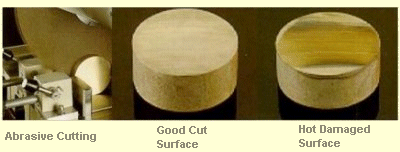
Alphabetical Index
Browse by Elements
Keyword Search
ASTM Electrolytes
Macro Etchants
Micro Etchants
Named Etchants
New Etchants
Al and Al Alloys
Cu and Cu Alloys
Fe and Fe Alloys
Ni and Ni Alloys
Carbide Etchants
Fluoride Etchants
Nitride Etchants
Other Etchants
Oxide Etchants
Phosphide Etchants
Single Crystal Etchants
Thin Film Etchants
Wafer Etchants
Help
Home
Cutting the Sample
The first thing to remember when cutting samples, is to preserve the sample axes orientation. Cut the sample in such a manner that important sample directions, like the Rolling Direction, Transverse Direction and Sample Normal are not lost. The second thing to remember that the cutting process must not damage or change the sample as this would lead to erroneous results.

Note: Image by courtesy of Oxford Instruments.
Avoid aggressive cutting methods that generate heat or cause deformation at the cut surface. Severe damage induced at this stage may extend so deep into the material that it is not removed by subsequent grinding and polishing. Heating caused during cutting may cause changes to the microstructure - phase transformations or precipitation/diffusions mechanisms may become active. Therefore heating must be avoided at all costs.
Abrasive cutters are common in the metallurgical industry and are suited to cutting larger sections of material. Often the sample is subjected to considerable force and heating, although if used with care, good cuts can be performed with minimal damage. Heating is the main problem, and using excessive force with an inappropriate wheel can cause a sample to locally glow red with heat. Manufacturers of cutting equipment and cut-off wheels publish tables and diagrams to help to make the choice of wheel easier. The importance of observing the manufacturer's recommendations cannot be over-stressed. If over-heating of the sample occurs, it is usually due to using a wheel that is too 'hard' for the material being cut. The wheel does not wear properly which causes the abrasive to become blunt. Another possibility is that the abrasive becomes clogged. Friction then causes excessive heating and damage to the sample. Heating often results in altered surface structures, which subsequent grinding and polishing do not remove.
The selection of abrasive wheel is therefore important to avoid introducing unnecessary levels of damage when cutting materials.
Precision, Low Deformation Cutting Machines
There are many examples of cutters on the market designed for precision and low damage cutting. Such machines normally employ boron nitride and diamond type cutting wheels, although other types may be available, depending on the machine.